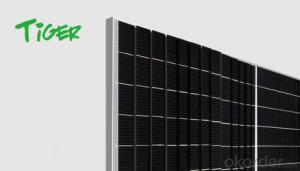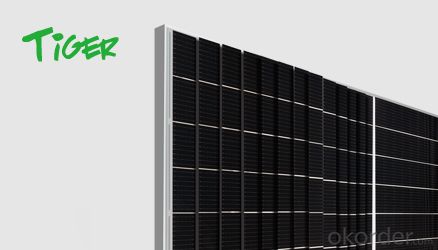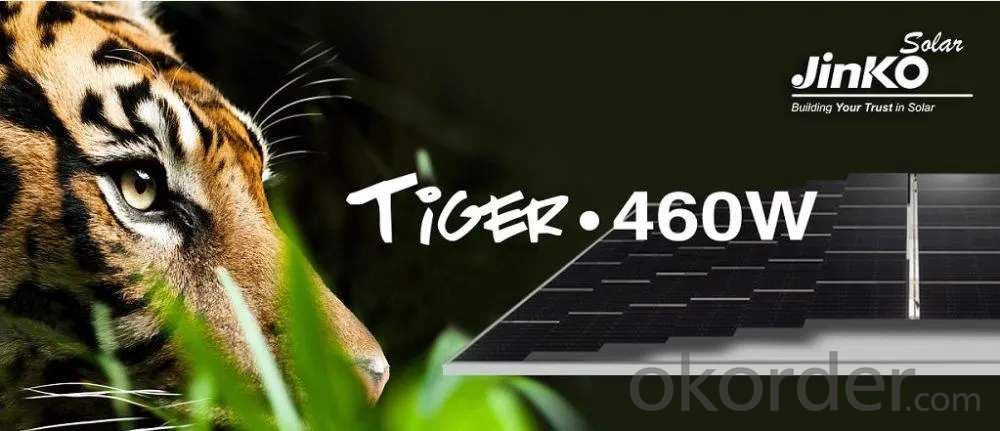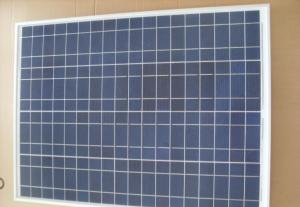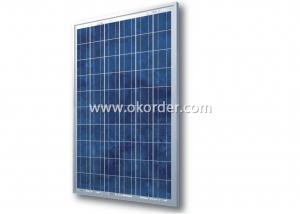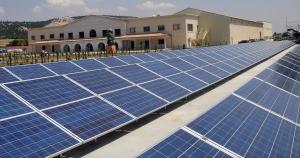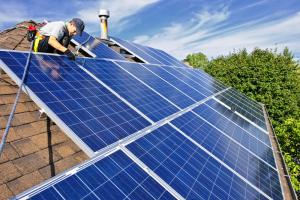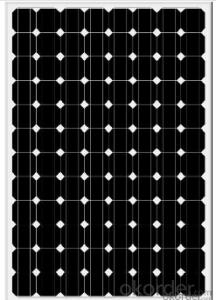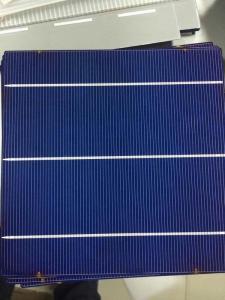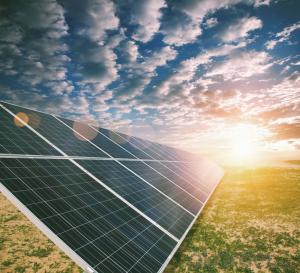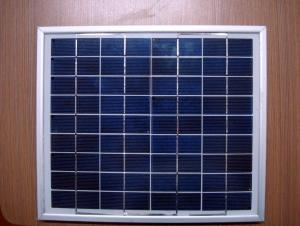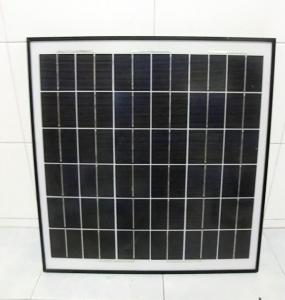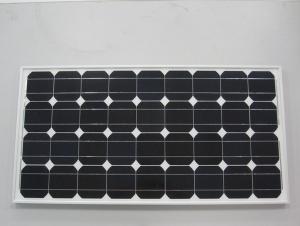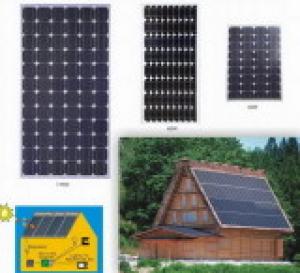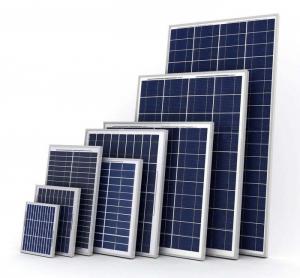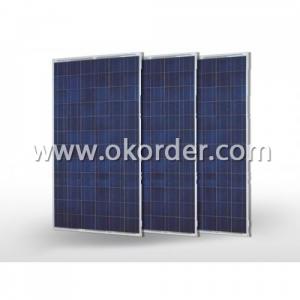Westinghouse Solar Panels - Jinko Solar Module Tiger Bificial DG 455-475 Watt
- Loading Port:
- Shanghai
- Payment Terms:
- TT or LC
- Min Order Qty:
- 1000 pc
- Supply Capability:
- 2000000 pc/month
OKorder Service Pledge
OKorder Financial Service
You Might Also Like
Specification
【Product Descroption】
With ensured after service, we can both supply tire one brand such as JINKO brand and do OEM for you. Poly, Mono, Half cell, Double glass, Thin film and so on are all available. Tiger Solar Panel is the new developed style of Jinko double glass mono solar panel.



【Advantage of Tiger Module】
(1)Ultra-high Power for the Lowest LCOE and Highest IRR
(2)Ultra-high Efficiency of 20.78%
(3)Reliable Tiling Ribbon Technology Eliminating the Inter-cell Gap
(4)9 Busbar Technology Decreasing the Resistance Loss
【SPECIFICATION】



Mechanical Characteristics
| Cell Type | P type Mono-crystalline |
| No of Cells | 156 (2×78) |
| Dimensions | 2205×1032×30mm (86.81×40.63×1.38 inch) |
| Weight | 29.6 kg ( 65.25lbs) |
| Front Glass | 2.0mm,Anti-Reflection Coating |
| Back Glass | 2.0mm, heat strengthened glass |
| Frame | Anodized Aluminium Alloy |
| Junction Box | IP67 Rated |
| Output cables | TUV 1×4.0mm2, (+): 250mm , (-): 150 mm or Customized Length |
【Warranty】
12 years Guarantee on product materail and workmanship
30 years Linear Power output warranty
0.45% Annual Degradation Over 30 years

【FAQ】
1.Q:What is your MOQ?
A:Usually it will be one container.Trial order is also available.
2.Q:Can you doOEM?
A:Yes,we can do OEM for you.Jinko Solar Panel is just one partner brand of us .
3.Q:What is your payment terms?
A:Usually for new customer,we will do TT or LC at sight.
- Q: Is there any way to charge my laptop with a solar panel? Is there any panel like that. Or if I work on panels can I do something like that. If you know anything about it, can you just help me? Thanks a lot.
- Deep Cycle Series batteries are designed to have a large amount of stored current discharged between charging sessions, with very heavy non-porous battery plates to withstand repeated major discharging and charging cycles (deep cycles). They are typically used where the battery is discharged to great extent and then recharged.
- Q: How do solar panel power systems work?
- Solar power works by making solar cells of two kinds of glass; one which has been “doped” to have too many electrons, and the other which has been “doped” to have too few electrons. These layers of glass are then glued together with a thin insulation layer in between them. The top layer of glass is the one with too many electrons, the bottom layer of glass has too few electrons, and the insulation allows electrons to pass from the bottom layer to the top layer easily, but not from the top layer to the bottom layer as easily. As photons come flying into this glass sandwich at the speed of light, the photons crash into the electrons in both layers and cause them to start moving. The electrons in the top layer are tightly packed and can’t move much, but the electrons in the bottom layer can move around enough that they end up crossing through the insulation into the top layer. However, because there are already too many electrons in the top layer, the newly arrived electrons have no place to rest. This buildup of electrons creates an “electrical pressure”. Then contacts are glued to the glass top and bottom, and a wire is added to connect the top layer to the bottom, and the electrical pressure which has built up in the top layer now has a way to escape, and the extra electrons which crossed over the bottom to the top can now return to the bottom layer. This flow of electrons from the top layer to the bottom layer is the electricity generated by the solar cell. A solar “panel” is made up of many of these cells wired in series to increase the voltage to make it high enough to do some useful work, such as charging batteries, and many of these panels can be wired together to do such things as supplying power to a building, or even supplying power to the utility grid.
- Q: I mean like bread is made of wheat, what are solar panels made up of?How are they manufactured?
- Solar panels (aka photovoltaic panel) are most often made up of thin wafers of crystalline silicon or cadmium telluride. As photons from the sun enter the photovoltaic cell, electrons are freed from the substrate when are then collected by wires that run throughout the panel. And as we know electrons=electricity!
- Q: . Does it really only cost $200 in contrast to $5000 or more?2. How much would it cost to build panels that would energize an entire average household? (washer, dryer, water heater, lights, fans, a/c)3. Is there a place to get the info on how to make them for free instead of paying E4E?4. Are the professional solar panels better? more efficient? 5. Will the electric company in So. Cal. really pay you?6. Do you have to be certified to do this professionally? or an electrician? If so what schools teach it?7. Would wind generators be of any use in So. Cal.? I mean don't you really need to get the fan spinning to get energy?8. Are there any extra unseen costs? (tools, energy converter, ect)9. How much is it to get an electrician to hook you to the grid?0. Is it better to hook to batteries or the grid? Pros, cons, why?
- I believe Earth4Energy to be a bald-faced scam, selling plans that will not do what is implied in the marketing, and imparting no information that is not publicly available on the internet, already. If you were to search for solar panel on torrent sites, most likely, some disgruntled customer has posted the material. It probably violates the E4E copyright, so I'm not suggesting that you get it in this manner. I'm going to skip many of your questions, given my already-stated opinion of Earth4Energy. Professionally-installed panels have a net cost of thousands of dollars in general. While they can save money (and Southern Cal is an ideal place for this), consider that it generally takes 0 years or more to get your money back. If you're on S Cal Edison, or SD Gas and Electric, you can go on net metering. They don't really pay you, they credit your electric bill. After a year, if you used more electricity than you generated, you pay them. If you generated more than you used, they reset the balance to zero and say thanks for your donation. You never really get a check, like in some other states. But you should have lower electric bills. You can put up panels for your own use without any certification. To put up panels professionally, you'll need a C-0 contractor's license from the state, or will need to be under the supervision of someone with such a license. But if it's the latter, you might just be the grunt that carries the panels off the truck and up the ladder, for minimum wage. I'd say better than 95% of residentail solar is connected to the grid, if the grid is available. It's a clear winner. Who wants to pay 50% more for their system, just to have batteries that need their water and acid checked all the time? Below is one of many unsatisfied customers from Earth4Energy. Be careful in your search, people selling these reports have bought up the keywords such as scam and ripoff to direct you back to sites selling the product.
- Q: Can solar panels be installed on a residential community or housing complex?
- Yes, solar panels can be installed on a residential community or housing complex. In fact, many residential communities and housing complexes are now opting for solar panel installations to generate clean and renewable energy. This not only helps reduce electricity costs for homeowners but also contributes to a more sustainable and eco-friendly environment.
- Q: what is needed beside the panels and do you need an electrician to hook it up
- The main components for a solar electric system are the panels, racks for mounting the panels, and inverter to convert the panel's DC power to AC, which can be pumped into the grid if necessary. There would also be various electrical supplies involved - wire, conduit, possibly a switch and/or circuit breaker. On the paperwork side, there's a building permit, permission from the power company to connect, and some inspections. Although it could be done by a homeowner, it's not a trivial project, and the best way to get it set up is to contract a professional solar installer. They all give free quotes, and can explain your various options when they visit.
- Q: Can solar panels be used in areas with high levels of bird droppings?
- Yes, solar panels can be used in areas with high levels of bird droppings. However, regular cleaning and maintenance may be required to ensure optimal efficiency of the panels.
- Q: In nature, green leaves collect light and produce energy. Is this what they copied to make solar panels? If not how hard would it be to make artificial leaves that would power our homes?
- Solar panels may have been inspired by leaves, by they don't function in the same way. Leaves use the sunlight to make carbon dioxide into carbohydrates. Solar-panels makes sunlight into electricity.
- Q: What is a good sight that I could go to about installing solar panels and all of the considerations of it?
- That okorder /... In both cases I would recommend you call to get specifics before ordering anything.
- Q: How much Electricity does a standard Solar panel producein terms of Watts and in terms of Units( i.e. electricity meter attached in our House)If I have 20 Solar panels and an inverter , how much electricity will I Be able to harness and store (state that in terms of volts)Can I run Arefridgerator, Iron, Heaters, Plasma T.V. and other high Electricity Consuming Devices.
- Take a look on OKorder at some of the books on how to design solar energy systems. It is a bit more complicated than you might expect. I'm not sure what you consider to be a standard solar panel, but the 3' ones I have produce about 5 watts of power in full sunlight. Put simply, you need to convert the power from the solar cells (variable voltage) into a constant voltage usable for charging a batteries. Most of the low cost modules for this purpose can't handle more than about 00 watts. Larger systems are available that handle thousands of watts but they are quite pricey. Since you can't take out more than you put into your battery system, you can calculate about how long you can run a high-current appliance based upon its wattage rating, that of the battery system (adjusted for loss of converting to AC), and the charging system.
Send your message to us
Westinghouse Solar Panels - Jinko Solar Module Tiger Bificial DG 455-475 Watt
- Loading Port:
- Shanghai
- Payment Terms:
- TT or LC
- Min Order Qty:
- 1000 pc
- Supply Capability:
- 2000000 pc/month
OKorder Service Pledge
OKorder Financial Service
Similar products
Hot products
Hot Searches
Related keywords
